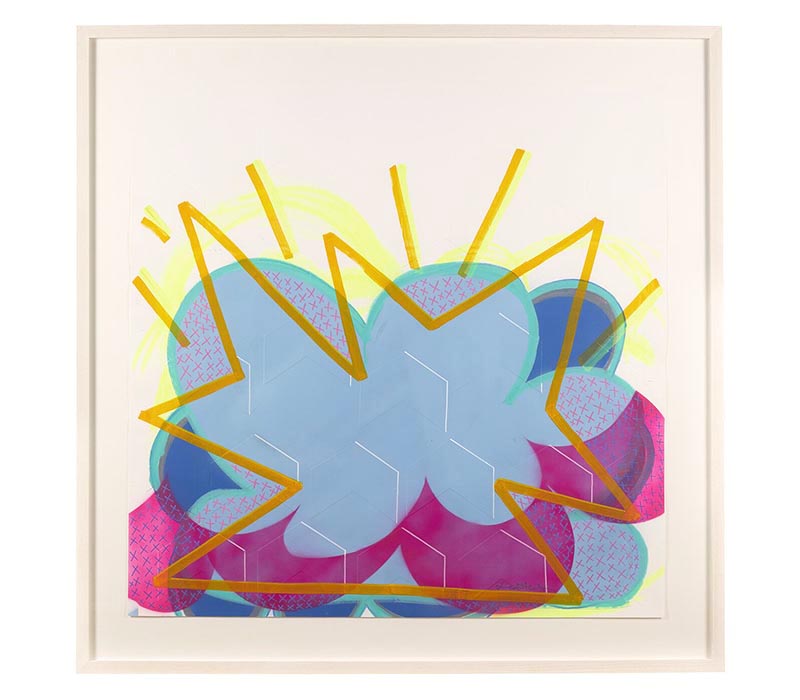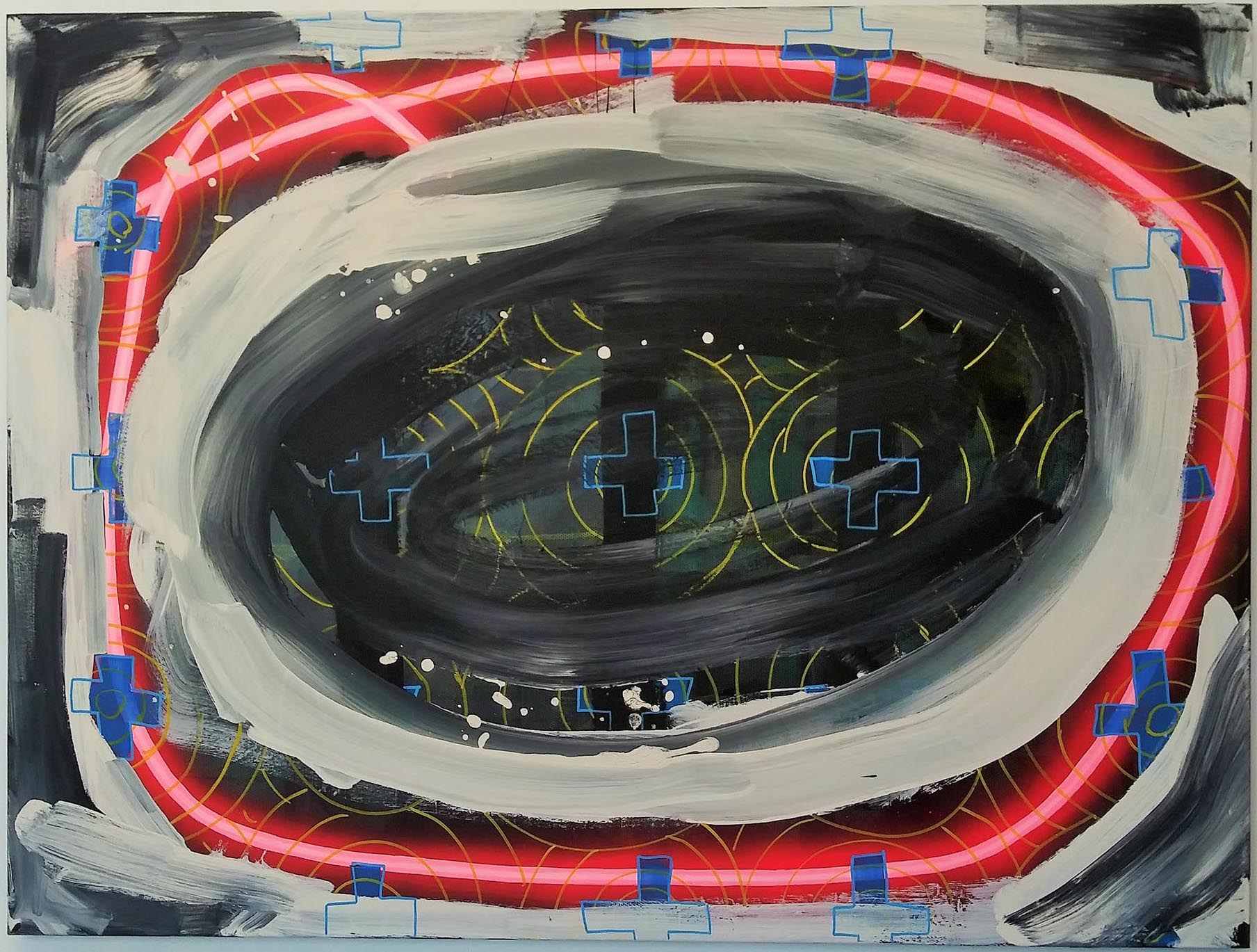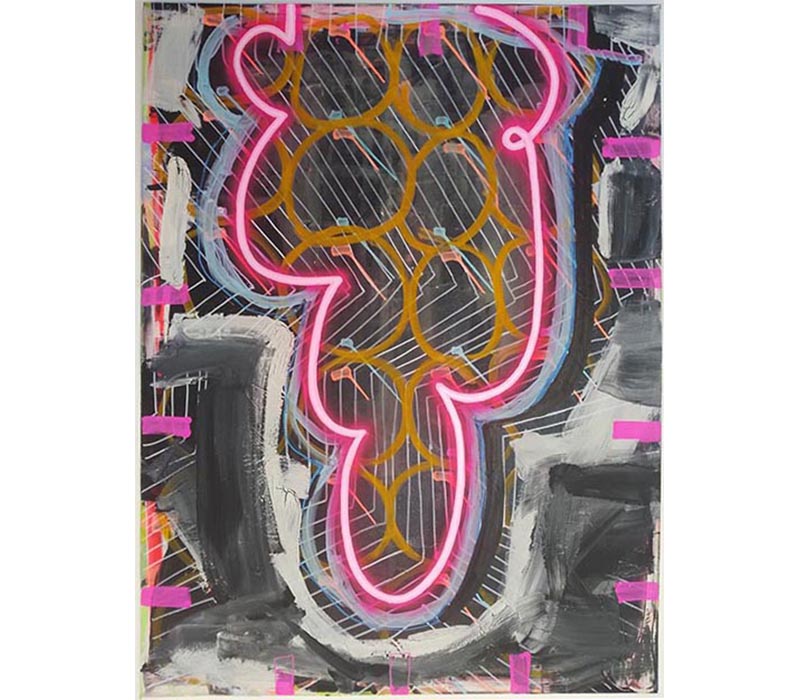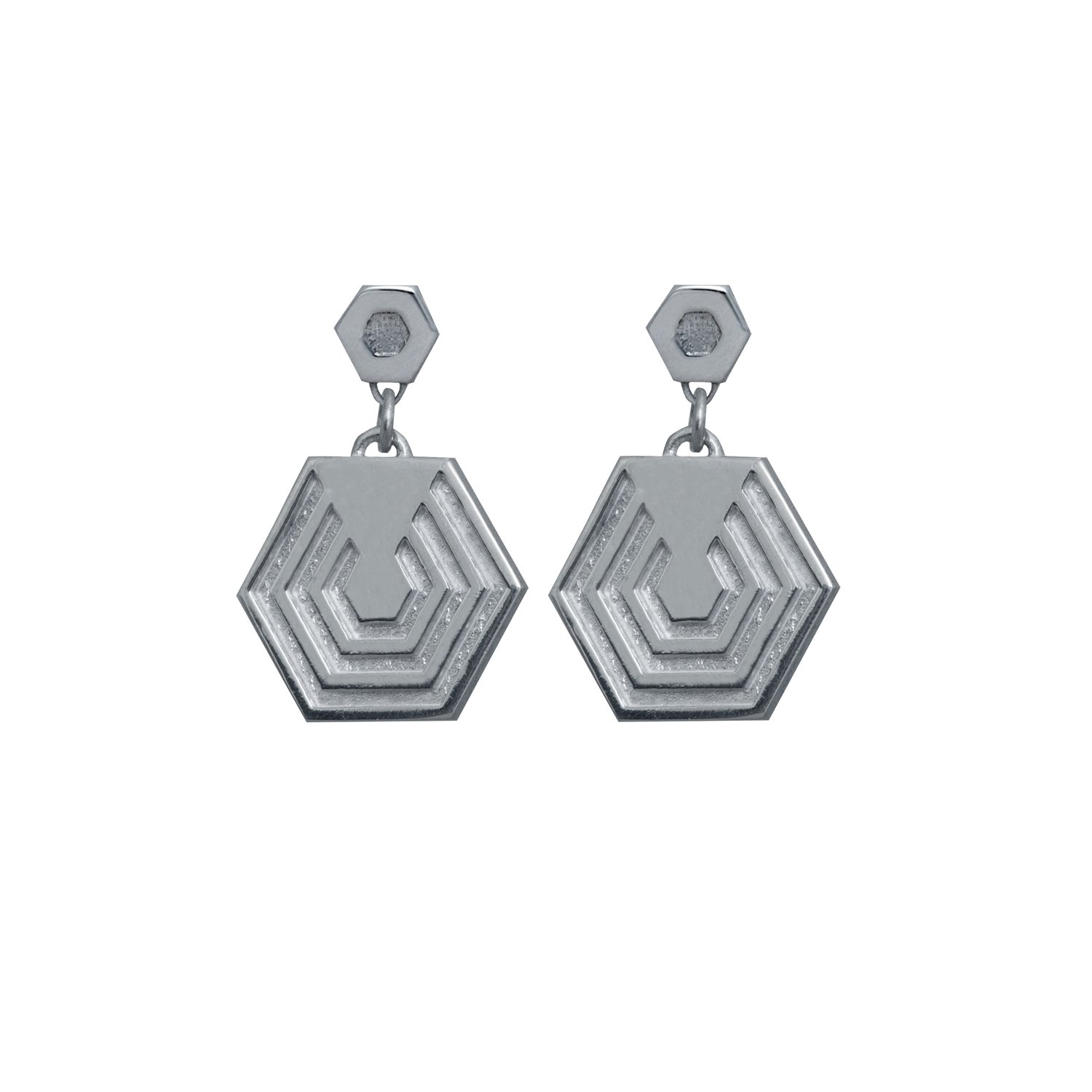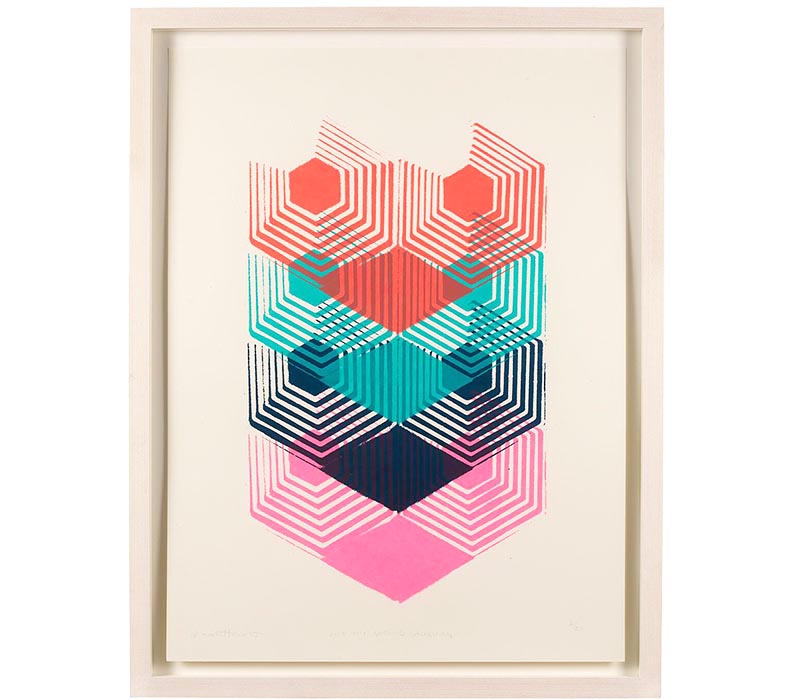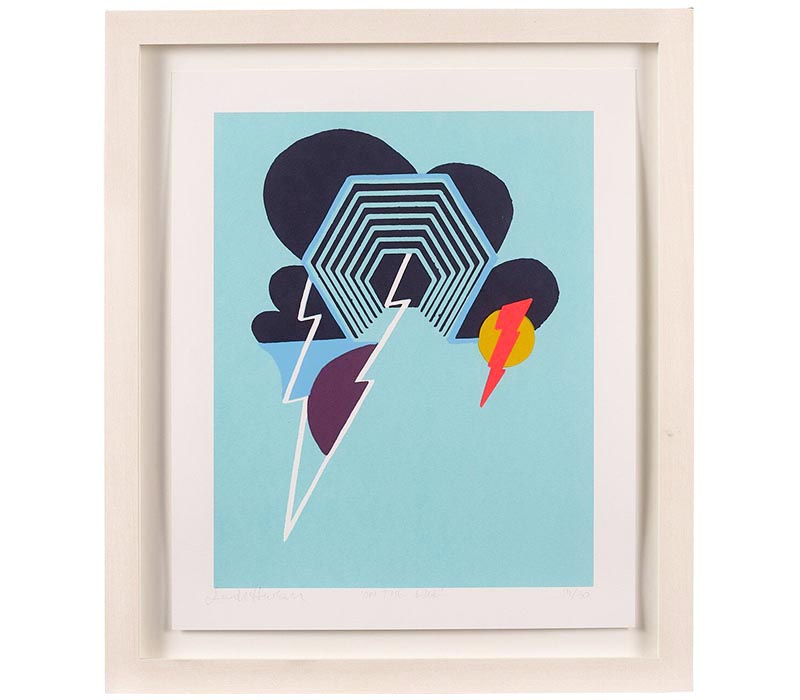Leah Hewson
Leah Hewson is an Irish contemporary artist who produces abstract works of art based on the workings of the human mind. Leah studies human behaviour, psychological theories and the unconscious mind and experiments with how these are visualised in fine art.
After graduating with a degree in Fine Art from IADT in 2010, Leah has gone on to have four solo exhibitions in Dublin, receive awards and even intern for Sean Scully’s studio in New York City in 2015. Now Leah has just finished a six month residency with the NARS Foundation in NYC and tells us of how this experience has influenced her work art making process.
‘Reflaction’, 2018, Vinyl on Acetate, NARS Foundation, NYC. Photo Credit: Leah Hewson
How did you get started?
I would say that I started twice. I went down the college route, graduating in 2010 and worked on some shows and commissions for about 5 years doing the part time hospitality work on the side. I enjoyed the work I was making but didn't feel fully convinced by what I was creating and anyway there was too much fun and travelling to be had in my 20s to concentrate fully on my career.
The second time was when I got into the RHA Residency in 2016. Previous to that I took about a year out, feeling jaded of creating all together, and got a job in film production. I enjoyed the steady income and structure of a 'regular job' but the itch was simmering to the surface and eventually I admitted to myself that creating art was vital for my sanity. The RHA residency was a big deal and a good opportunity to re-enter which was not to be taken lightly. I made it my job and began to take my career as an artist seriously. The time I had taken off gave me the space to reflect on what I wanted and to figure out how to make work that I felt was true to myself as an artist. At that time I made a drastic move from figuration into abstraction realising that by taking the figure out of the work I could put more of myself into it. This was a very transformative time for me both personally and professionally. I turned 30 and shed the skin of caring what others thought of me and my work and it was almost an overnight liberation that I was finally forming the life I wanted for myself.
‘Rowdy’, 2018, Acrylic and Lacquer on Embossed Paper, 86 x 86cm, The Devlin Hotel. Photo Credit: Leah Hewson
What was it like working with Sean Scully and how did this collaboration impact your work?
Working with Sean Scully was a pivotal moment for me. Up until that point I never really understood abstract art but by spending so much time surrounded by it, it opened my eyes up to its possibilities. Soon after I decided to move into abstraction.
It was also incredible to see a man at the top of his artistic career and the production and administration behind the scenes, so I learned a lot of the practical side of it too.
‘Anagram’, 2018, Acrylic and Lacquer on Canvas, 137 x 198 cm, NARS Foundation, NYC. Photo Credit: Leah Hewson
You have said that your work is influenced by aspects and theories of psychology. Can you elaborate on this?
I have a big interest in human behaviour and trying to understand people's actions, particularly my own. I think that is part of the motivation for my work, is that I’m trying to discover more about myself through the creative process. I recently came to a realisation that I spent a lot of my formative years hiding behind people, not really fully forming my own opinions and finding it hard to express myself thoroughly through the english language. But with art I’m creating my own language, and expression on my terms. I think this is why I ultimately have the need to create. It comes from a very deep and long standing place.
When I decided to go abstract I knew I would have to have some sort of grounding for the work, so I began to read about psychology, particularly Jung and Freud's theories on the unconscious. And it wasn't until I began to read about it that I really got excited at how much I’m fascinated by it all, although Im still very new to the whole subject and even the language itself.
‘Empress’, 2019, Acrylic and Lacquer on Canvas, 122 x 92 cm, NARS Foundation, NYC. Photo Credit: Leah Hewson
I found a Jungian theory called the ‘Process of Individuation’ which kick-started it all. This is how something passes from your unconscious mind into your consciousness based on your personal experiences, memories, repressed memories, dreams and active imagination. I wanted to try and find a way to access this unconscious space and adapt this theory to perform in a visual art context; to work in the space before something becomes an idea. What I love about this way of working is that I'm trying to sit in the unconscious space, but that in itself is a paradox. 95% of brain activity happens on an unconscious level, so for me without even looking out into the physical world there's already so much to explore.
Recently I've been experimenting with bringing the layers in my work out into the physical space. In doing so, it became clear that my work was moving into something more optical than expressive, so I began to research the role the unconscious plays within the visual brain, looking at the overlapping of psychology and neurology. Questioning 'Is what we see reality?' and also trying to understand that our visual system as humans has evolved just enough purely for our survival and at the peripheral of its capacity is where optical illusions occur. This gives a great insight into parts of the visual brain that are otherwise hard to reach but also confronts the fact that a lot of the time when we take in the world we believe what we are experiencing to be reality.
‘Height Study 2’, 2019, Digital Rendering, NARS Foundation, NYC. Photo Credit: Leah Hewson
Can you take us through your art making process?
I adapt the 'Process of individuation' theory as a starting point for painting. The main idea is to have impulsive reactions to materials, surface, colour, shapes etc. and work in a real instinctive manner. It lends itself to the process to work on multiple pieces at one time, building up layers so that each piece becomes like a documented glimpse of my unconscious.
‘Emperor’, 2019, Acrylic and Lacquer on Canvas, 92 x 122 cm, NARS Foundation, NYC. Photo Credit: Leah Hewson
My recent work though in trying to bring the layers out into the physical space through installation, sculpture and video work has to come from the opposite space in that it has to be something considered and worked out, particularly with optics where math and formulae are quite an important component. It’s interesting to have both going at the same time and in doing this I realise that the painting is for me, whereas everything else I’m making is to further the progress of my work. I recently spent 2 weeks editing a video loop, which I had never made before so I was learning on the job, and realised all of a sudden that I was quite irritated. It was because I was static for so long and I hadn't expelled energy and pure expression around the studio through painting in some time. So I now know that the painting will always be there, even if the work keeps moving into a more experiential space and pushing it towards different materials.
Left: ‘Atari’, Right: ‘Gobble Up’, 2018, Acrylic, Lacquer and Wallpaper on Wood Panel, 4 x 8 ft. Photo credit: Leah Hewson
I generally don't keep any notebooks in the traditional sense, as I don't really plan things out. I think with my hands and feel that exciting things happen in the spaces between an intended mark and something accidental. Every mark made is an important component, particularly in my painting.
Having worked with different medium (paint, sculpture, digital etc.) how did working with jewellery differ? At that time did you find yourself focused more on design and less on the artistic process of producing work?
The collaboration with Edge Only was such an interesting learning curve. I got to know so much about the production of making jewellery, the marketing aspect and the commercial side. It's a whole other world but it definitely over laps. I think my work can be quite graphic in its content so I thought that the transition into design would be a pretty organic one.
The process started loose and expressive in the way that I usually make paintings but then isolated the sweet spots of what I was making to design a repeated pattern for the packaging. The screen prints and jewellery myself and Jenny designed came out of this pattern. To be honest, we didn't even know where we wanted the collaboration to go but it seemed to grow naturally into a cohesive collection that exhibited the cross over between art and design quite successfully.
How do you challenge yourself artistically?
I'm just coming off the back of a 6 month residency in New York which has blown my mind! Before this point I only considered myself a painter and printmaker but just by being open and having conversations with other artists working in different mediums it made me think in a different way. I made this huge suspended pillar out of clear acrylic and perspex, it's still a work in progress, but it's been the most humbling thing I've made in a long time because its not cooperating in the way that I want it to. This lesson is vital, especially because Im shit for being patient and get too excited to see the finished projects I work on! It's important to keep these types of projects going as a challenge to grow and learn.
I've also began to bring my work into a digital format which is totally new for me, and slow so it's also another great lesson in patience.
‘Monument’, 2019, vinyl on clear acrylic, 243 x 72cm, NARS Foundation, NYC. Photo Credit: Leah Hewson
How has working with different artists impacted your approach and process of making art?
I only realised in NY that making art is actually a collaborative process, even if you are working in the studio on your own, which I am all the time, as soon as you think about showing your work it becomes a collaboration, and then even more so when the audience views and participates with the work. Before I went to NY I had been in a makeshift studio on my own for about a year, which was an amazing time of good isolation in its own right. When I landed in NY I was surrounded by other artists, all working in different mediums, coming from different countries and cultures so the conversations we had bent my mind in many directions. I was also lucky enough to be in a place where I wasn’t working towards a show so it was a safe time to really experiment and go wild. I explored the idea of resolving my interests objectively rather than just going straight to paint. I became open to the questioning of 'Can I resolve this better through a different medium?', and just allowed the mediums themselves to answer the question. If that makes sense ha!
‘Monument’ (detail), 2019, vinyl on clear acrylic, 243 x 72cm, NARS Foundation, NYC. Photo Credit: Leah Hewson
What do you want viewers to take away from your work?
I've been thinking about this a lot recently, particularly in response to the shite state of affairs that our world is in right now. That perhaps I should be making something political that responds to people's raw emotion. But I realise that the most important thing for me is to make work that is true to myself and if it is colourful and optimistic and gives people respite from their shit for a while then I'm happy to offer that. I make sure that I experience and nurture joy in my life so I would like my work to give back in that way.
With my work moving into the optics route I've never considered the experience of the viewer more. I'm trying to find a way to make it more immersive, experiential and sensory but we'll see where it goes!
‘Monument’ (detail), 2019, vinyl on clear acrylic, 243 x 72cm, NARS Foundation, NYC. Photo Credit: Leah Hewson
Plans for the future?
I have a busy 2019 which is great! I'm going to be making some limited edition prints as soon as I get home and will be working on my first public piece too. I've got a residency in Iceland for 2 months to finish off the year.
Also I’m shortlisted for the Hennessey Craig Biennial Scholarship Award which will see the 10 artists exhibit at the RHA in a group show this September. Its an amazing opportunity to win €20,000 so the work I’m making for it has been simmering away for a while so now I just have to make it haha. We'll see how that goes too!
I want to make plans to get back to NY too...I find it an incredibly inspiring and energetic place to work.



